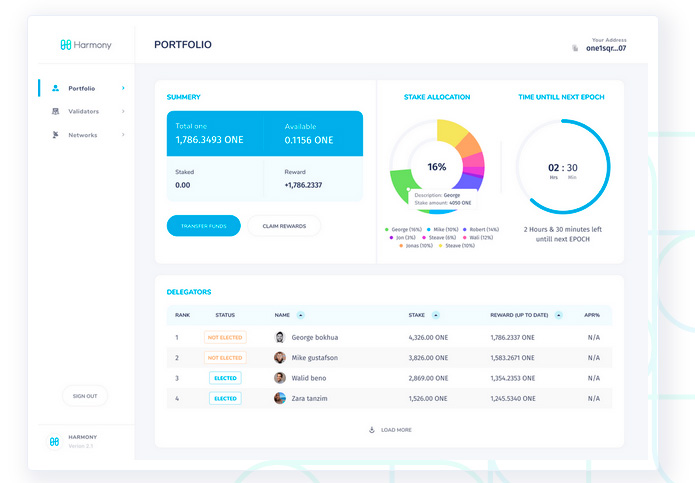
Since 2017 many of Harmony’s founding team members would gather every week for hours in the tradition of Google TGIF to share world-changing ideas over drinks.

The team is of infrastructure engineers in Silicon Valley, including 4 PhD, 7 ex-Google/Amazon/Apple/Facebook, 2 Harvard MBA, and Stanford/Berkeley AI graduates. Our mission is to scale trust for billions of people and create a radically fair economy. Each BLS key will be used separately to bid for a slot and if successful, the key is obligated to validate blocks.Harmony is a fast and secure blockchain.
Bls-pubkeys: One or multiple BLS public keys the validator will sign with. Rate: The commission fee (%) the validator charges from the block reward. Amount: The amount of ONE tokens the validator will stake initially. It’s worth clarifying some of the important fields in more detail: There are many fields to configure for your validator. Start validating using the node(s) with the BLS key(s) you added in your validator record Setup a validator node(s) and let it fully synchronized with the latest blockchain.Ĭreate an on-chain validator record by sending a CreateValidator transaction. To become a validator in Harmony, you will need to do the following: BLS keys) which will be used to sign on validated blocks. A validator can specify one or multiple validating keys (a.k.a. Harmony Wallet (Harmony Browser Extension)Ī validator in Harmony blockchain is a single person or entity who stakes tokens and runs nodes (validator client software) to validate blocks. Currently, staking transaction is supported on Ledger Nano S, Harmony Browser Extension and Math Wallet, you can log in or create a new address via those three wallets. You can go to Harmony Staking Dashboard to delegate/undelegate tokens, claim rewards and manage your delegations. Meanwhile, stake delegation, reward compounding, double-sign slashing, and unavailability checking are also supported. EPoS allows staking from hundreds of validators and the unique effective stake mechanism reduces the tendency of stake centralization. Harmony’s Effective Proof-of-Stake (EPoS) is the first staking mechanism in a sharded blockchain that achieves both security and decentralization. Within an epoch, the validators in each shard stay the same and run consensus repeatedly. As detailed in whitepaper, Harmony blockchain runs in epochs and one epoch lasts for every 16,384 blocks, which is roughly 1.5 days in current block time. One bonded voting share grants one vote for a validator to cast in the FBFT consensus. ValidatorsĬurrently there are 320 open validator slots, 80 on each shard, to validate new blocks and vote to reach consensus using FBFT algorithm where a 2/3 quorum of votes is needed for consensus.To be able to vote, validators need to have voting shares bonded to them. In case of indifference or indecisiveness, you should distribute your delegations among multiple validators in order to minimize risk. As a delegator, you should carefully choose validators based on their historical performance metrics such as APR, uptime and commission. Your delegated tokens are also associated with slashing risks of the validator. The block rewards can also be staked again to achieve the compounding effect of staking. The earned block rewards are stored in a separate reward balance of the delegator, which can be immediately withdrawn to the delegator’s account balance. 
If the tokens are delegated to an elected validator, a portion of the block reward earned by the validator will be credited to the delegator (according to section Block Reward). Harmony ONE holders can delegate their tokens to existing validators using staking explorer. Delegatorsįor those wishing to participate in staking without running a validator, delegation is the best approach to still get involved and earn block rewards.

All transaction fees are burnt to offset the insurance, naturally leading to zero inflation when network usage becomes high. This model gives validators a simple and predictable return. Harmony Economics Model caps the annual insurance at 441 million tokens (about 3% rate in long term).

To support 100% uptime but fully open participation, EPoS slashes validators who double-sign and it penalizes elected but unavailable nodes. Staking mechanism supports delegation and reward compounding. Effective Proof-of-Stake (EPoS) reduces centralization and distributes rewards fairly to thousands of validators. Harmony has designed a novel Proof-of-Stake (PoS) mechanism for network security and economics.








 0 kommentar(er)
0 kommentar(er)
